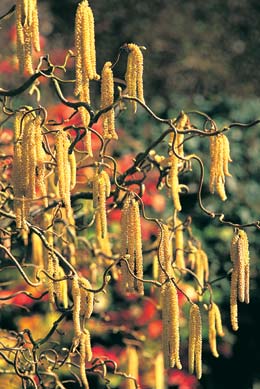
|
|
Contorted hazel
- Corylus avellana Contorta
|
Contorted hazel
- Corylus avellana
Contorta
The genus Corylus consists of about ten hardy,
deciduous, large shrubs or small trees from the temperate regions of the Northern
Hemisphere. These plants are commonly known as Filberts, Hazels, or Hazelnuts. Many varieties are grown for their edible
nuts, while others are grown for ornament. The most important kinds grown for their nuts are the
Filberts, which are varieties and hybrids of C. avellana and C. maxima. C. maxima
var. Purpurea (Purple-leaves Filbert) is a large shrub with beautiful, rounded, purple
leaves. C. avellana (European Filbert) is a large shrub or small, multi-stemmed
tree.
Though C. avellana produces small, round nuts known as
cobnuts, the filbert (Corylus maxima) bears larger nuts that ripen earlier in the
season. Filberts, which are native to the Balkans. They traditionally collected and brought into church on August 22 - Saint Philibert's Day - hence the ancient name of
filbert.
Of the 10 species of hazel spread across the temperate areas of the Northern
hemisphere, only one reaches tree-like proportions - the Turkish hazel (Corylus
colurna). This tree has a fissured, corky trunk supporting a pyramidal crown and is often planted as a formal
feature.
Propagation can be by seed, tip-layering or radical suckers and
cutting. Hazels will grow in shade as well as in full sunlight and are lime-tolerant. Grows 15 ft in 20
years.
The nuts were of course eaten. It is rich in fatty oils and vitamins. Weight for weight they contain 50% more
protein, 7x more fat and 5x more carbohydrate than hen's eggs.
The oil is multi-usable and has been employed for cooking or dressing salads, as well as in oil
paints, as a machine lubricant and in making perfumery and cosmetics.
The wood of the Hazel is not long
lasting, but since Hazel rods are extremely pliable (and abundant), they have been used for a great variety of
purposes: basket work, wattle and daub frames, hurdles to pen sheep and other fencing
panels, thatching spars, coracle frames (Coracles are the Celtic basket like
boats), bender poles (a bender is a temporary tent as used by travelers, peace protesters and so
on), hoops, fishing rods, walking sticks, broom handles and so on.
Forked hazel twigs are traditionally used for water divining.
C. avellana var. Contorta (Harry Lauder's Walking
Stick) is an interesting, picturesque shrub that slowly reaches a height of up to 10
feet. This shrub
features twisted and spiraling branches, twigs and leaves. Monoecious (separate male and female flowers on the same
plant). Male flowers appear in spring in showy, 2-3" long, yellowish brown
catkins. Female flowers are insignificant. Although the species is commonly grown commercially for nut
production, this cultivar usually does not produce fruits (nuts). Round, double-toothed, light green leaves (2-3"
long) typically turn an undistinguished yellow in fall. After leaf drop, the contorted form of the branches becomes quite noticeable and provides winter
interest.
This shrub needs careful attention to pruning for it to develop into an attractive
plant, rather than a gnarled mess. It is beneficial to leave a few main stems only so that their twists are clearly
defined. This shrub also produces pretty catkins in the winter.
The name Corylus -Korylos was the Greek name for a
Hazelbush,
and the name 'Avellana' is thought to refer to Avella Vecchia, a city in Southern
Italy, finely situated in fertile territory and its nuts (nuces Abellanae) and fruit were renowned in roman
days.
The variety name Contorta refer to contorted shape of the plant.
This intricate form of
this hazel in the early 1860s. An eminent Victorian gardener, Canon Ellacombe of
Bitton, spotted the tangled stems and propagated the plant to amuse his friend Edward Augustus
Bowles.
Bowles loved plant curiosities and aberrations enough to dedicate part of his large garden near
Enfield, Middlesex, to his oddities. His original plant - the first contorted hazel in cultivation - still grows in the
'Lunatic Asylum' (as Bowles named it) at Myddelton House today.
Once established in Bowles's garden, other famous gardeners admired its
sculptural, bonsai-like charms. In the early years of the 20th century it acquired another name - Harry Lauder's Walking Stick - after the popular Scottish
entertainer. Sir Harry Lauder (1870-1950) was a Scot & a leading music hall entertainer who sang lovely ballads & told jokes on
himself. He was greatly beloved in his day, & was knighted by King George V for service to the country in the first World
War, wherein his only son was killed.
Corkscrew hazel is a natural mutant of wild
hazel, carrying a mutation that produces contorted shoots and distorted leaves. The mutation causing the abnormal growth is not transmitted via the
seeds, so the plant can only be grown from cuttings, or via grafts onto normal hazel
rootstocks.
The contorted hazel makes an excellent container plant and can be combined with spring bulbs and hellebores in a
winter-to-spring arrangement, where - with care - it will survive for many years.
One of the winter highlights in a garden is the gnarled silhouette of the "corkscrew
hazel" - Corylus avellana 'Contorta'. In low sunshine, the pale sky provides the perfect backdrop for its dark and tortuously twisted
branches.
Source:
http://www.botany.com/corylus.html
http://www.the-tree.org.uk/BritishTrees/TreeGallery/hazelc.htm
http://www.telegraph.co.uk/gardening/
main.jhtml?xml=/gardening/2002/01/19/ghow19.xml
